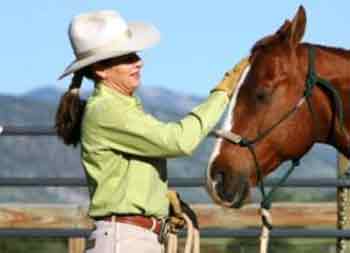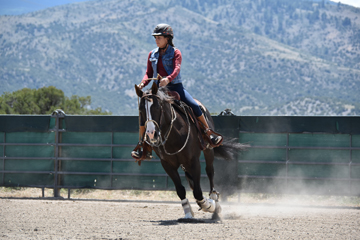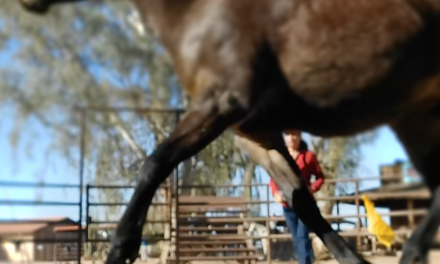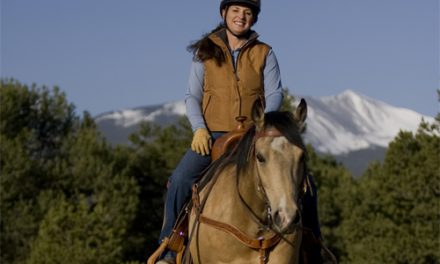Riding Right with Julie Goodnight
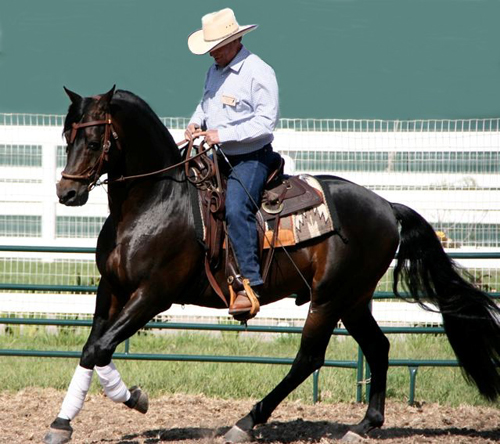
Dear Julie,
My horse is a Friesian/Warmblood cross. Even though he moves beautifully, he has a big trot and he’s not exactly smooth. I am hoping to show him in Dressage— at the higher levels—and I won’t be able to post the trot. How can I learn to sit the trot smoothly instead of bouncing all over the saddle and jarring my back?
Bounce A Lot
Dear Bounce A Lot,
I think sitting a trot can be one of the most difficult skills to master in horseback riding. The fact that you’re riding a big moving horse with rough gaits at a strong pace—which dressage requires—makes the challenge even more daunting. Like any athletic skill, if you get your technique right and develop strong muscle memory, you’ll get it! As your horse moves up the training levels and begins to work in a more rounded frame, his gaits will smooth out some. However, you’ll have to be able to sit the trot to get him there.
The trot is a gait of suspension. That means all four of the horse’s feet come off the ground at the same time. His back lifts and drops with each beat of the stride. Your goal is to move your body exactly with the horse’s movement— lifting and dropping to absorb the motion in his back without losing contact with the saddle. You’re not trying to sit down on the horse to burden his back. Instead, your goal is to move in rhythm with him, like a dance partner.
To start practicing for a perfect sitting trot, you’ll need to have soft and open joints that act as shock absorbers. You’ll also need to use your abdominal muscles to lift and drop your pelvis in time with the lift in your horse’s back. Riding a big horse with a strong trot, you’ll need excellent coordination and well-toned core muscles.
First, check your position. To be in balance and rhythm with the horse at any gait, you need to have your skeletal system aligned—ear-shoulder-hip-heel in a straight line—and have all of your joints soft and relaxed. Your joints are shock absorbers, especially your hips, knees and ankles. Tense muscles lead to locked joints—which is the number one cause of bouncing on the horse. Check that you have a balanced position and that all of your muscles and joints are soft and relaxed. Balance and rhythm in the saddle are covered in volume one in my DVD series Goodnight’s Principles of Riding.
Next, you’ll need to develop muscles and coordination that will allow you to move your hips in perfect timing with the movement in your horse’s back at the sitting trot. This will require you to isolate your abdominal muscles and master the pelvic tilt—which is why Pilates has become such a popular exercise routine for equestrians. Fine movements in Pilates help you isolate and control your pelvic movements.
In the sitting trot, your hips move both vertically (up and down) and laterally (side to side). Your horse’s back also moves in these directions as he trots. When he pushes off with his right hind, the right side of his back muscles contract and you feel a lift in your right hip; the next stride you’ll feel your left hip lift. At the same time, both hips will lift up and drop down in a vertical motion. You do not create this motion, the horse does, but you’ll have to use your muscle memory to follow the motion with your hips.
Here are some visual aids to help you sit the trot. First, think of sitting on a trampoline or exercise ball and bouncing your bottom up and down, without actually lifting up off the surface. To generate that motion from your seat, you’ll use your abdominal muscles, a pelvic tilt and the spring in the tramp to create the up and down motion. Bouncing your bottom on a trampoline or exercise ball is very similar to how you sit the trot and move vertically with the horse. You’ll be like a ballerina who pre-jumps in a lift so it’s easier on her partner to lift her up over his head. When you can move in rhythm with the horse, you can control the horse’s rhythm with your seat—a skill you’ll need to excel in for dressage (or any discipline for that matter).
Another useful image for sitting the trot is to imagine you’re pedaling a bicycle backwards as you trot. This helps you coordinate the lateral and vertical motion that your hips make at the sitting trot. You can try the exercise while sitting in a chair with both feet on the ground. Pedal with your hips—not your feet— and you’ll feel the vertical and lateral movement that’s similar to trot. This and 23 more exercises to improve your riding are on volume 3 in my riding series, called “Perfect Practice.”
Without question, it’s easier to learn the sitting trot on a smaller, smoother horse at slower speeds. The faster and bigger the trot, the harder it’s to sit. Many riders have had success practicing and conditioning on an exercise ball that emulates the horse. Make sure you use a high-grade ball strong enough to use as a desk chair, 55-75 cm.
In my riding videos, Goodnight’s Principles of Riding, Volumes 1-5, position, balance and the rhythm of all the gaits are addressed, as well as many other topics to improve your riding. It helps to have visual guidance as you learn to perfect your riding. You can order DVDs and exercise balls online at www.JulieGoodnight.com.
Good luck with your riding and with a little work, you can easily become the rider your horse deserves! Keep up with your lessons and be sure to visit my website for help on your riding skills.
Enjoy the ride!
Julie Goodnight, Trainer and Clinician
www.juliegoodnight.com
In this series, master trainer and clinician Julie Goodnight discusses the riding terms and techniques you probably know (or should know). She’ll define rein, seat and leg cues you’ll need for the best communication with your horse. Then she’ll help riders solve problems with their own horses. Learn the proper terms and apply your aids for a better grasp of horsemanship and a better riding relationship with your horse. Watch Horse Master.tv with Julie Goodnight on RFD-TV, every Wednesday at 5:30p EST—DirecTV channel 379, Dish Network channel 231.

